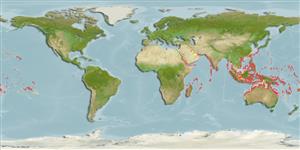Environment: milieu / climate zone / depth range / distribution range
ນິເວດວິທະຍາ
ສັດທະເລ ກ່ຽວກັນຫີນ; ບໍ່ມີການເຄື່ອນຍ້າຍ; ລະດັບຄວາມເລິກ 0 - 30 m (Ref. 37816). Tropical; 30°N - 30°S, 30°E - 139°W
Indo-Pacific: Red Sea and East Africa to French Polynesia, north to the Ryukyu and Ogasawara islands, south to Queensland, Australia.
Length at first maturity / ຂະໜາດ / ນ້ຳໜັກ / Age
Maturity: Lm ?, range 24 - ? cm
Max length : 40.0 cm SL ຕົວຜູ້/ບໍ່ມີເພດ; (Ref. 3503); common length : 27.0 cm TL ຕົວຜູ້/ບໍ່ມີເພດ; (Ref. 5450); ນ້ຳໜັກສູງສຸດທີ່ເຄຍຈັດພີມມາ: 2.4 kg (Ref. 11441)
ຄີ (ໜາມ)ແຂງຢູ່ຫຼັງປາ (ທັງໝົດ) : 12 - 14; ຄີຫຼັງຂອງປາ (ຄີອ່ອນ) (ທັງໝົດ) : 5 - 7; ຄີ(ໜາມ) ແຂງຢູ່ຄີກົ້ນປາ
ກຸ່ມປາກະດູກແຂງ
ຄວາມຖີ່ຂອງກຸ່ມຖ່າຍທອດພັນ
ປາທີ່ມີການເຄື່ອນຍ້າຍຈາກທະເລໄປຫານ້ຳຈືດ ແລະນ້ຳຈືດຫາທະເລ
ປາທີ່ມີການເຄື່ອນຍ້າຍຈາກທະເລແລະໄປໄຂ່ຢູ່ນ້ຳຈືດ
ຄີກົ້ນຂອງປາ
ສັດທີ່ມີກະດູກສັນຫັຼງ
ການຖ່າຍທອດທາງກຳມະພັນຈາກພໍ່ແມ່ຫາລູກ: 3; ຄີກົ້ນຂອງປາ: 5 - 6. Colors matching surroundings and extremely well-camouflaged (Ref. 48635). Pelvic and anal fins spines are similarly developed. 12-14 stout grooved spines, each with a large venom sack at its base (Ref. 37816).
Most widespread stonefish (Ref. 4313). Found on sandy or rubble areas of reef flats and shallow lagoons and in small pools during low tide well camouflaged among the substrate and sometimes even covered with algae (Ref. 5213, 5503). Solitary species (Ref. 37816). Feeds on fishes and crustaceans. The dorsal fin has 2 grooves serving as seringes of venom; their stings are excruciatingly painful and can occasionally be fatal. A serum exists which is effective if applied immediately after the infliction. World's most venomous fish (Ref. 37816). Uncommon in markets. In Hong Kong live fish markets (Ref. 27253). Also Ref. 57406.
Life cycle and mating behavior
ການຈະເລີນເຕັມໄວ | ການສືບພັນ | ການວາງໄຂ່ | ໄຂ່ | ຄວາມດົກຂອງໄຂ່ປາ | ຕົວອ່ອນ
Poss, S.G. and K.V. Rama Rao, 1984. Scorpaenidae. In W. Fischer and G. Bianchi (eds.) FAO species identification sheets for fishery purposes. Western Indian Ocean (Fishing Area 51). Vol. 4. FAO, Rome. pag. var. (Ref. 3503)
IUCN Red List Status (Ref. 130435: Version 2024-1)
Human uses
ການປະມົງ: ທີ່ເປັນການຄ້າໜ້ອຍ; ຕູ້ປາ: ເປັນສີນຄ້າ
ເຄື່ອງມື
Special reports
Download XML
ແຫຼ່ງອີນເຕີເນັດ
Estimates based on models
Preferred temperature (Ref.
123201): 24.9 - 29.3, mean 28.3 °C (based on 3300 cells).
Phylogenetic diversity index (Ref.
82804): PD
50 = 0.5312 [Uniqueness, from 0.5 = low to 2.0 = high].
Bayesian length-weight: a=0.01622 (0.00615 - 0.04280), b=3.05 (2.82 - 3.28), in cm total length, based on LWR estimates for this (Sub)family-body shape (Ref.
93245).
ຊັ້ນເຂດຮ້ອນ (Ref.
69278): 4.4 ±0.77 se; based on food items.
ຄວາມຢືດຢຸ່ນ (Ref.
120179): ຕຳ່, ປະຊາກອນຕຳ່ສຸດທີ່ໃຊ້ເວລາສອງເທົ່າ 4.5 - 14 ປີ (Preliminary K or Fecundity.).
Fishing Vulnerability (Ref.
59153): Moderate vulnerability (39 of 100).
Nutrients (Ref.
124155): Calcium = 44.5 [23.4, 89.6] mg/100g; Iron = 0.595 [0.308, 1.576] mg/100g; Protein = 18.1 [16.6, 19.6] %; Omega3 = 0.192 [0.084, 0.511] g/100g; Selenium = 27.6 [14.6, 69.1] μg/100g; VitaminA = 182 [59, 523] μg/100g; Zinc = 1.05 [0.72, 1.54] mg/100g (wet weight);
